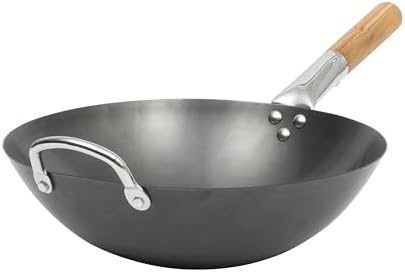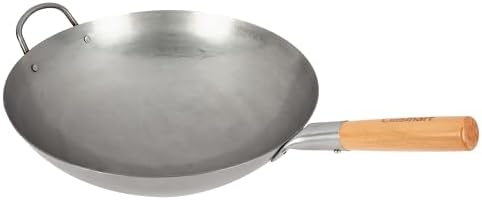Understanding Carbon Steel Woks
Carbon steel woks are cooking vessels. They consist of a mild steel alloy. The alloy contains more carbon than normal stainless steel. Asian cooking usually favors them. This is due to the fact that they conduct heat well and respond quickly while cooking. The unique material composition causes carbon steel woks to heat up quickly. This aids in stir-frying, an essential process in most Asian dishes. Unlike woks that are stainless steel in nature, carbon steel woks develop a non-stick coating. They do so naturally by seasoning. Seasoning involves applying oil. When heated, the oil chemically binds to the metal.
Benefits of carbon steel woks extend beyond the heat distribution. They are lighter than the cast iron wok. This makes them easy to move around when one is cooking. They retain heat absolutely. This is important for achieving the coveted ‘wok hei’—the breath of the wok. This is one basic flavor attribute of stir-fry recipes. These woks can with use, seasoning, and care over time acquire a deep patina. This enhances their non-stick qualities as well as their looks.
To maintain a carbon steel wok in working order, seasoning is needed. This is what creates the non-stick surface. It also protects the metal from rust and corrosion. Without seasoning and maintenance, users may experience non-stickiness issues. Food gets sticky as a consequence. It also proves to be troublesome during cooking. Therefore, it is important to know what carbon steel woks require. This will grant them the best performance and life. In the following sections, we will highlight common non-stick problems that users might encounter. We will also give practical solutions to improve your cooking process.
Common Non-Stick Problems with Carbon Steel Woks
Carbon steel woks are used for better heat retention and flexibility. They do suffer from non-stick problems, though. Sticking of food to the surface is one of the problems. It can be frustrating to the newcomer to carbon steel woks. Food sticking is generally due to inadequate seasoning of the wok. It also occurs when cooking temperature is too low. A seasoned wok acquires a natural non-stick surface. An unseasoned one leads to sticking food.
Rust is another common problem. It develops if the wok gets wet or isn’t dried quickly after cleaning. While rust-free stainless steel does not require washing, carbon steel must be washed frequently. It keeps it from oxidizing. The presence of a wet sponge or not drying the wok thoroughly after cleaning generates rust spots. They adversely affect its performance and appearance. Employing a thin coat of oil after cleaning avoids the occurrence of moisture. It lowers the possibility of rusting as well.
The burnt residues are also a problem. Food cooked on extremely high heats or left unattended has a tendency to burn quickly. This provides tough burnt areas to work with during cleaning. These residues rob from the non-stick nature of the cooking surface. They also impart unwanted flavor to subsequent cooking. To avoid this issue, monitor the cooking temperature. Apply correct methods, such as deglazing the wok after long periods of cooking. This prevents a dirty and inefficient cooking surface.
Understanding these common non-stick problems sticking of food, rusting, and burnt residues is the solution to effective carbon steel wok usage. Through proper knowledge and practices, users can enhance their cooking experience. They can also lengthen the life of their cookware.
Effective Solutions in Maintaining Non-Stick Properties
Maintaining a carbon steel wok’s non-stick properties includes proper seasoning techniques. Proper maintenance and awareness of cooking practices are also needed. These practices maintain its surface. First, seasoning is essential. It creates a protective layer. This accumulates the wok’s non-stick properties. To season your wok, start by thoroughly cleaning it. Remove factory oils or manufacturing impurities. Following cleaning, heat the wok over a medium flame until it’s dry. Introduce then a thin layer of high-smoke-point oil. Flaxseed or grapeseed oil works well. Swirl the oil to cover the entire cooking surface. Ensure an even coverage. Heat until it begins to smoke lightly. Then leave to cool and do this cycle multiple times. This forms a robust non-stick coating.
Adequate maintenance is also necessary. It prevents rust and keeps the wok working. Do not soak the wok in water after each use. This may promote rusting. Warm water wash it instead. Use a soft sponge to clean. Mild scrubbing pad for heavy food residue. Don’t remove the seasoned coating. Dry the wok well before storing. Lightly oil after washing. This protects the surface again and makes it non-stick.
During cooking, heat the wok gradually. Never expose the wok to drastic changes in temperature. These result in warping and damage to the seasoning. Use wood or silicone implements. This is to avoid scratching the surface. Avoidable typical mistakes consist of cooking with excess moisture. Also, never use cooking sprays. These produce a residue toxic to the wok’s non-stick properties. By following these rules, you ensure the longevity of your wok made of carbon steel. You also ensure that the non-stick capabilities of your wok are in their optimal state.
Comparative Analysis: Carbon Steel vs. Other Materials
Cookware material has a decisive impact on cooking quality. Carbon steel woks have some advantages and limitations. That is compared to other cookware material. Some of them are cast iron, stainless steel, and non-stick varieties. One of the most important points of comparison is non-stick abilities. Chemically coated surfaces are employed by conventional non-stick frying pans and saucepans. These are resistant to food sticking to them. A seasoning forms a natural non-stick surface on a carbon steel wok. This method relies on the formation of a polymerized oil layer. This coating attaches to the metal. It is a reversible non-stick surface. This surface resists enhanced functionality with use. Maintenance of it, however, demands repeated seasoning. This may be more energy-consuming than a straightforward clean of a conventional non-stick pan.
As far as holding heat, carbon steel woks are optimal. This is due to the fact that they possess high heat resistance. They also conduct heat uniformly. This aspect comes in handy with quick cooking techniques like stir-frying. Compared to this, cast iron too displays high heat retention. It is, however, heavier in weight and takes longer to heat up. Stainless steel, while not so much related to non-stick quality, is more resilient. It does not react to acidic foods either. This makes it compatible with the majority of cooking techniques. It may, however, be less effective in delivering the high heat required in wok cooking.
The results of cooking in every material are also varied. Carbon steel woks can achieve the desired sear on foods. Such flavor is developed more intensely than some non-stick items. Non-stick coatings, however, may inhibit browning and caramelization. This is due to lower heat capacities. This may affect the general flavor of foods. Moreover, although non-stick cookware provides easy cleaning, durability is often questioned. The coats wear out over time.
Lastly, while carbon steel woks present special challenges, particularly in the maintenance of their non-stick properties, they also bring with them awesome benefits. These enhance cooking processes. They allow chefs to create dramatic results if properly cared for.












